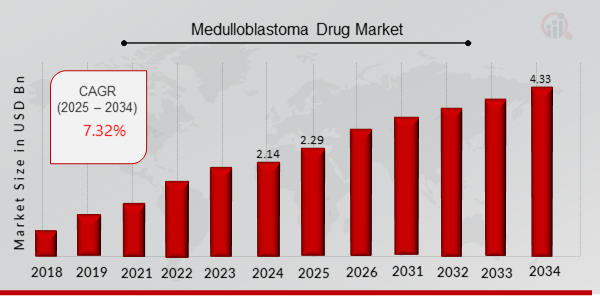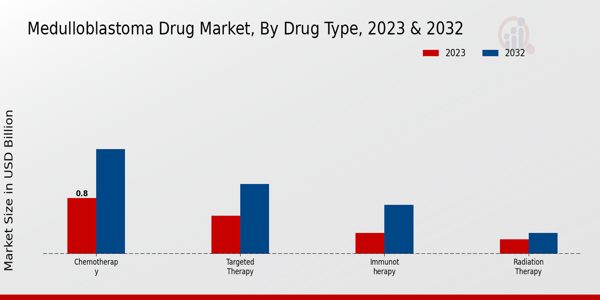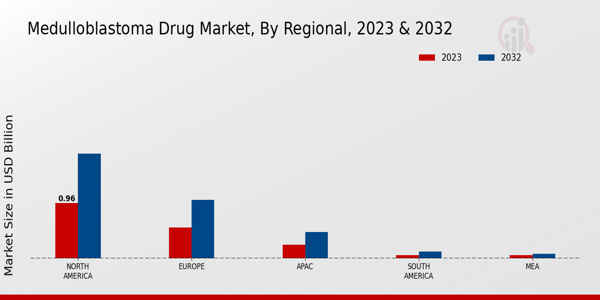Medulloblastoma Drug Market Overview
As per MRFR analysis, the Medulloblastoma Drug Market Size was estimated at 2.14 (USD Billion) in 2024. The Medulloblastoma Drug Market Industry is expected to grow from 2.29 (USD Billion) in 2025 to 4.33 (USD Billion) till 2034, at a CAGR (growth rate) is expected to be around 7.32% during the forecast period (2025 - 2034).

Source Primary Research, Secondary Research, MRFR Database and Analyst Review
Key Medulloblastoma Drug Market Trends Highlighted
Several important drivers operate on the medulloblastoma drug market, which determine its growth patterns. The worldwide prevalence of medulloblastoma among children, particularly in nascent economies, remains a key factor in escalating the need for suitable drugs. The level of progress made in research and development also or the potential for effective new treatments plays a significant role in the market, as does the level of awareness of the disease and the need for effective drugs. Also, increasing workforce collaboration between drug companies and universities aims to augment the volume of potential therapies into the pipeline, which also enhances market growth.
In regard to the current cancer treatment market, the focus is on less invasive and more effective cancer medications with fewer side effects. The possibility of developing such individualized treatments in the future is realistic, as long as the current field of research can provide a feasible concept. Moreover, opportunities to combine medications with innovative delivery methods could lead to substantial progress in treatment outcomes. Emerging markets are also a major opportunity because improved access and investment in cancer care makes new treatments essential in unserved areas. In recent years, several trends have been observed in the medulloblastoma drug market, one of which is the expansion of immunotherapy as a treatment method.
This shift indicates a broader movement towards harnessing the immune system's capabilities in combating cancer. Furthermore, advancements in genomic medicine are leading to a better understanding of medulloblastoma subtypes, which may refine treatment protocols. Additionally, the trend towards clinical trials focusing on pediatric patients highlight a growing recognition of the importance of early treatment intervention. Collectively, these trends reflect a dynamic landscape in the medulloblastoma drug market, driven by innovation and changing healthcare paradigms.
Medulloblastoma Drug Market Drivers
Increasing Prevalence of Medulloblastoma
The rising number of medulloblastoma cases among pediatric populations has become a significant driver for the Medulloblastoma Drug Market Industry. Several factors contribute to this trend, including improved diagnostic techniques and heightened awareness among healthcare providers regarding childhood cancers. As healthcare systems enhance their ability to recognize symptoms and confirm diagnoses, the number of reported cases has naturally surged.
An increase in awareness among parents about the signs and symptoms of brain tumors has also driven more children to seek medical attention earlier than before. This trend is critical, given that early-stage diagnosis leads to more favorable treatment outcomes. The burgeoning research landscape focusing on pediatric oncology is enhancing our understanding of medulloblastoma, propelling the demand for innovative treatment options. Additionally, as more targeted therapies and personalized medicine approaches enter the market, they will likely attract investment and interest, ultimately increasing availability for patients worldwide.
This situation underscores a vital correlation between the prevalence of medulloblastoma and the corresponding expansion of the Medulloblastoma Drug Market Industry, creating ample opportunities for pharmaceutical companies and healthcare providers to contribute positively to patient care while simultaneously tapping into a growing market. Effective patient advocacy campaigns and educational programs continue to raise the profile of pediatric cancers, further emphasizing the urgency for targeted therapeutic interventions.
The projected market growth reflects the societal commitment to addressing these needs and ensuring that children diagnosed with this condition receive optimal care.
Advancements in Drug Development
The Medulloblastoma Drug Market Industry is witnessing significant advancements in drug development, which are essential for the treatment landscape. Research and development efforts continue to yield new therapies aimed at improving patient outcomes, particularly those in high-risk categories. Innovations in biotechnology and pharmacogenomics have paved the way for more targeted therapies, enhancing the efficacy of treatments while minimizing side effects.
As new agents undergo clinical trials and receive regulatory approvals, they provide hope for better management options. Furthermore, collaboration between academic institutions and pharmaceutical companies fosters an environment rich in research, crucial for emerging therapies aimed specifically at medulloblastoma.
Government Initiatives and Funding
Government initiatives aimed at improving cancer research and treatment represent a vital driver for the Medulloblastoma Drug Market Industry. Increased funding for research initiatives, especially in pediatric oncology, encourages the development of innovative therapies. National health organizations and regulatory authorities are actively supporting clinical trials, which is crucial for the evaluation of new drugs. Enhanced allocation of resources toward understanding medulloblastoma at a genetic and molecular level will accelerate advancements in the development pipeline, ultimately benefiting patients.
These initiatives not only bolster confidence among researchers and investors but also pave the way for establishing robust safety and efficacy profiles for emerging treatments.
Medulloblastoma Drug Market Segment Insights
Medulloblastoma Drug Market Drug Type Insights
The Medulloblastoma Drug Market reflects a diverse landscape within its Drug Type segmentation, emphasizing various treatment approaches tailored to combat this complex condition, with an overall market valuation expected to reach 1.86 USD Billion in 2023. Chemotherapy emerges as a dominant force in this sector, accounting for a valuation of 0.8 USD Billion in 2023 and projected to rise to 1.5 USD Billion by 2032, showcasing its majority holding in the market due to its effectiveness in targeting rapidly dividing cancer cells. Targeted Therapy also plays a significant role, represented by a market value of 0.55 USD Billion in 2023, with expectations to grow to 1.0 USD Billion by 2032. This approach utilizes specific drugs designed to attack cancer cells while sparing normal cells, making it an essential component in contemporary treatment regimens.
In contrast, Immunotherapy accounts for 0.3 USD Billion in 2023, with potential growth to 0.7 USD Billion by 2032. Immunotherapy's growing significance is reflected in its ability to harness the body's immune system to fight cancer, which is being increasingly recognized as a pivotal element in comprehensive treatment strategies. Meanwhile, Radiation Therapy, valued at 0.21 USD Billion in 2023, is projected to reach 0.3 USD Billion by 2032. Although it represents the smallest segment, its precise application in localized treatments contributes meaningfully to patient outcomes.
The growth drivers within this market are fueled by advancements in medical technology, increased research investments in Medulloblastoma treatments, and a rising incidence of this condition among pediatric populations. However, challenges such as high treatment costs and accessibility may hinder market growth. Yet, with expanding knowledge regarding Medulloblastoma and the development of novel therapies, numerous opportunities arise within the Medulloblastoma Drug Market. Understanding the Drug Type segmentation not only highlights the therapeutic options available but also underscores the dynamic nature of this market, driven by continuous innovation and the quest for more effective treatment methodologies.

Source Primary Research, Secondary Research, MRFR Database and Analyst Review
Medulloblastoma Drug Market Route of Administration Insights
The Route of Administration segment of the Medulloblastoma Drug Market plays a crucial role in treatment efficacy and patient compliance. In 2023, the overall market is valued at 1.86 billion USD, with projections for growth driven by advances in pharmaceutical formulations and delivery methods that enhance therapeutic outcomes for patients. Among the various administrative routes, intravenous (IV) administration holds significant importance due to its rapid onset of action and ability to deliver potent therapies directly into the circulation, making it a common choice for acute settings.
Oral administration is gaining traction, especially for its convenience and non-invasive nature, appealing to both patients and caregivers. Meanwhile, intrathecal administration is vital for direct delivery to the central nervous system, effectively bypassing barriers that could limit drug penetration, thus playing a critical role in managing medulloblastoma. The evolving landscape of treatment options and patient preferences emphasizes the need for innovative delivery systems across these methods, positioning the Medulloblastoma Drug Market for continued growth amidst emerging challenges and opportunities.
Medulloblastoma Drug Market Patient Age Group Insights
The Medulloblastoma Drug Market is poised for significant growth, driven by various factors including an increase in awareness and advancements in treatment options. In 2023, the market was valued at USD 1.86 billion, reflecting its expanding nature. The market demonstrates considerable segmentation based on Patient Age Group, primarily focusing on Pediatric and Adult demographics. The Pediatric segment holds a substantial share as Medulloblastoma predominantly affects children, which necessitates targeted therapies that are effective and carry a reduced risk of side effects.
This sub-segment is critical in shaping market dynamics due to the urgent need for innovative treatments tailored for younger patients who comprise a significant proportion of cases. Conversely, the Adult segment is also vital, accounting for a growing number of cases driven by factors such as increasing life expectancy and evolving diagnostic practices. As research continues to unfold treatment avenues for both age groups, key players in the Medulloblastoma Drug Market are expected to strive for new drug development, thereby bolstering market growth and enhancing patient outcomes.
The ongoing trends and strategies aimed at improving therapeutic effectiveness highlight the importance of this segmentation in addressing the distinct needs of Medulloblastoma patients of varying ages.
Medulloblastoma Drug Market Distribution Channel Insights
In 2023, the Medulloblastoma Drug Market revenue reached 1.86 billion USD. The Distribution Channel segment plays a crucial role in the accessibility and delivery of medications required for treating this condition, with various avenues being employed. Hospitals are essential to the distribution landscape, as they provide comprehensive treatment plans and direct patient care, thus often being the first point of contact for patients receiving Medulloblastoma drugs. Pharmacies also contribute significantly, facilitating prescription fulfillment and offering patient guidance on medication use.
Meanwhile, Online Pharmacies have emerged as a vital channel, particularly in recent years, helping patients access medications conveniently and efficiently from their homes. With market growth driven by an increasing awareness of pediatric cancers and advancements in treatment options, understanding the Medulloblastoma Drug Market segmentation by distribution channels is vital for stakeholders aiming to optimize supply chain strategies and enhance patient support. The forecasted market statistics highlight not only the potential for growth in the hospital and pharmacy segments but also the transformative role that Online Pharmacies can play in improving patient access and healthcare outcomes.
Medulloblastoma Drug Market Regional Insights
The Medulloblastoma Drug Market revenue highlights the dynamic growth across various regions, with a notable valuation of 1.86 USD Billion in 2023. North America stands as a dominant force in this market, holding a significant share with a valuation of 0.96 USD Billion in 2023, expected to expand to 1.82 USD Billion by 2032, reflecting its majority holding due to advanced healthcare infrastructure and higher research investments. Europe follows with a solid valuation of 0.54 USD Billion in 2023, anticipated to grow to 1.02 USD Billion, driven by increasing awareness and innovative treatment approaches.
The APAC region, while smaller at 0.24 USD Billion in 2023, is rapidly developing, with its market expected to reach 0.46 USD Billion, showcasing emerging opportunities in Asia’s growing healthcare sector. South America and MEA, each at 0.06 USD Billion in 2023, project modest growth, with valuations increasing to 0.12 USD Billion and 0.08 USD Billion respectively by 2032, yet they represent the least presence in the landscape due to fewer resources and less clinical development. Overall, the Medulloblastoma Drug Market segmentation demonstrates varied growth patterns that reveal the critical drivers and opportunities present in different regions, shaping the industry’s future trajectory.

Source Primary Research, Secondary Research, MRFR Database and Analyst Review
Medulloblastoma Drug Market Key Players and Competitive Insights
The Medulloblastoma Drug Market is characterized by an evolving landscape influenced by continuous advancements in research and the development of novel therapeutics. Competitive insights in this market reveal a dynamic interplay among pharmaceutical companies striving to innovate and cater to the unmet clinical needs associated with this aggressive brain tumor, primarily affecting children. The landscape is shaped by a notable emphasis on targeted therapies, immunotherapies, and combination treatments, which aim to enhance treatment efficacy while reducing adverse effects. The increasing prevalence of medulloblastoma and a growing pool of patients have driven companies to invest heavily in research and development activities to establish a stronger foothold in this niche market. The competition intensifies as stakeholders seek to secure preferred positions in regional markets, thus engaging in strategic collaborations and partnerships to bolster their offerings.
In the context of the Medulloblastoma Drug Market, Pfizer stands out with a robust portfolio of oncology products and extensive research capabilities. The company leverages its strong market presence to enhance its competitive advantage, focusing on innovative therapies that address medulloblastoma treatment challenges. Pfizer’s strengths include its established reputation in the pharmaceutical industry, a strong distribution network, and significant investments in clinical trials targeting medulloblastoma therapeutics. Furthermore, Pfizer is committed to advancing its research initiatives through collaboration with academic institutions and healthcare organizations, allowing the company to stay ahead in the competitive landscape, address evolving patient needs, and adapt to regulatory changes. This proactive approach, paired with strategic marketing and educational initiatives, positions Pfizer favorably in the Medulloblastoma Drug Market.
Amgen has also made significant strides within the Medulloblastoma Drug Market by utilizing its expertise in biotechnology and advanced drug development. The company emphasizes the importance of innovation and has dedicated resources towards researching potential therapies that can effectively target medulloblastoma. Amgen's strengths lie in its strong pipeline of biologic therapies and its commitment to precision medicine, which aligns with the increasing trend of personalized treatment options in oncology. The company’s capabilities in drug formulation and delivery enhance its offerings, making them more accessible to healthcare providers. By focusing on partnerships and collaborations with research institutions and other biopharmaceutical companies, Amgen continues to position itself as a formidable player in the medulloblastoma space, working diligently to uncover novel treatment methods that hold the promise of improving patient outcomes and survival rates.
Key Companies in the Medulloblastoma Drug Market Include
- Pfizer
- Amgen
- Merck
- Eli Lilly
- Celgene
- Takeda Pharmaceuticals
- Ipsen
- Roche
- Sanofi
- AstraZeneca
- Novartis
- BristolMyers Squibb
- Regeneron Pharmaceuticals
- Gilead Sciences
- Johnsonand Johnson
Medulloblastoma Drug Market Industry Developments
Recent developments in the Medulloblastoma Drug Market have seen a surge in innovative therapies, significantly affecting drug valuations and investment strategies among key players such as Pfizer, Merck, and Roche. Analysts indicate that advancements in targeted and immuno-oncology treatments are reshaping treatment paradigms, raising market expectations. There has been notable collaboration among pharmaceutical firms, particularly Eli Lilly and Amgen, focusing on genetic research to enhance drug efficacy, marking a pivotal shift towards precision medicine. Additionally, AstraZeneca has engaged in partnerships aimed at leveraging biomarker research, which could lead to more effective solutions in the pediatric space. Recent acquisitions include Gilead Sciences acquiring a biotech company specializing in rare cancers that potentially includes medulloblastoma indications, reflecting a strategic focus on broadening their oncology portfolio. Moreover, the increasing awareness of childhood neuro-oncological conditions has stimulated funding and support for R&D, further bolstering the market. Companies like Novartis and Bristol-Myers Squibb are also investing in clinical trials, emphasizing a robust pipeline aimed at improving patient outcomes and potentially altering the treatment landscape for medulloblastoma.
Medulloblastoma Drug Market Segmentation Insights
Medulloblastoma Drug Market Drug Type Outlook
- Chemotherapy
- Targeted Therapy
- Immunotherapy
- Radiation Therapy
Medulloblastoma Drug Market Route of Administration Outlook
- Intravenous
- Oral
- Intrathecal
Medulloblastoma Drug Market Patient Age Group Outlook
Medulloblastoma Drug Market Distribution Channel Outlook
- Hospitals
- Pharmacies
- Online Pharmacies
Medulloblastoma Drug Market Regional Outlook
- North America
- Europe
- South America
- Asia Pacific
- Middle East and Africa
| Report Attribute/Metric |
Details |
|
Market Size 2024
|
2.14 (USD Billion)
|
|
Market Size 2025
|
2.29 (USD Billion)
|
|
Market Size 2034
|
4.33 (USD Billion)
|
|
Compound Annual Growth Rate (CAGR)
|
7.32 % (2025 - 2034)
|
|
Report Coverage
|
Revenue Forecast, Competitive Landscape, Growth Factors, and Trends
|
|
Base Year
|
2024
|
|
Market Forecast Period
|
2025 - 2034
|
|
Historical Data
|
2020 - 2024
|
| Market Forecast Units |
USD Billion |
| Key Companies Profiled |
Pfizer, Amgen, Merck, Eli Lilly, Celgene, Takeda Pharmaceuticals, Ipsen, Roche, Sanofi, AstraZeneca, Novartis, BristolMyers Squibb, Regeneron Pharmaceuticals, Gilead Sciences, Johnson and Johnson |
| Segments Covered |
Drug Type, Route of Administration, Patient Age Group, Distribution Channel, Regional |
| Key Market Opportunities |
Increase in R investments, Advancements in precision medicine, Growing awareness and diagnosis, Development of targeted therapies, Collaboration between biotech firms. |
| Key Market Dynamics |
Increasing incidence of medulloblastoma, Expanding treatment options and innovations, Growing investment in research, Rising patient awareness and advocacy, Favorable regulatory environment for therapies |
| Countries Covered |
North America, Europe, APAC, South America, MEA |
Frequently Asked Questions (FAQ) :
The Medulloblastoma Drug Market is expected to be valued at 3.5 USD Billion by 2034.
The projected CAGR for the Medulloblastoma Drug Market from 2025 to 2034 is 7.3%.
North America is expected to hold the largest market share, valued at 1.82 USD Billion in 2034.
The market value of Chemotherapy in the Medulloblastoma Drug Market is expected to reach 1.5 USD Billion by 2034.
The market for Targeted Therapy is expected to be valued at 1.0 USD Billion by 2034.
Immunotherapy is projected to reach a market size of 0.7 USD Billion by 2034.
The anticipated value of Radiation Therapy is expected to be 0.3 USD Billion by 2034.
Key players in the market include Pfizer, Amgen, Merck, Eli Lilly, and Roche, among others.
The market value for Europe in the Medulloblastoma Drug Market is expected to reach 1.02 USD Billion by 2034.
The expected market size for the APAC region is anticipated to be 0.46 USD Billion by 2034.

















